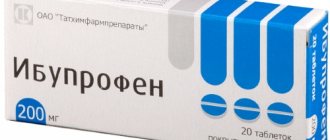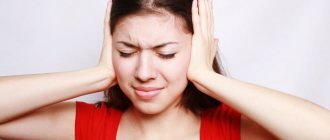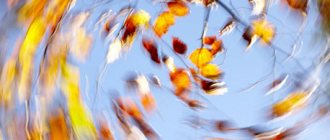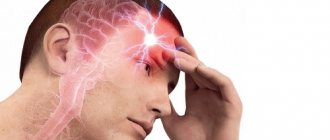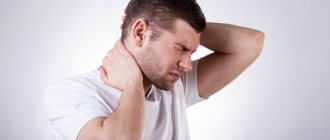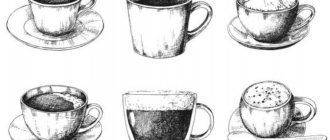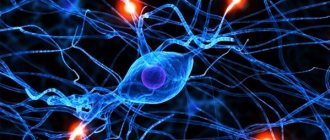One of the causes of tinnitus may be low blood pressure. Often this ringing in the ears is accompanied by headache and even nausea. Noise and pain arise, as a rule, unexpectedly and the person has no idea what the reason is. Usually the patient has no other signs of low blood pressure; moreover, he may not even know that he is hypotensive, attributing the symptoms to workload and a poor daily routine. Meanwhile, this is a symptom of a serious illness that requires a visit to a medical facility.
Noise in the head and ringing in the ears: causes, treatment with folk remedies
The vertebrae of the neck always bear a heavy load. In addition, they are quite fragile and the intervertebral discs wear out quickly. Destructive changes occur in them, and compactions appear in the adjacent muscles. Deformed cartilage pinches veins and arteries and compresses the sympathetic nerve plexus.
Blood circulation to the brain is disrupted, and oxygen deficiency develops. Tissue hypoxia occurs and intracranial pressure increases due to impaired venous outflow. The result is tinnitus.
For this reason, the nutrition of the middle and inner ear is disrupted, and the vestibular apparatus suffers, which leads to ringing.
Factors provoking ringing in SCH:
- smoking and drinking;
- caffeinated drinks;
- head and ear injuries;
- pathologies of the heart and kidneys;
- viral infections.
All this complements the narrowing of the arteries.
In all age groups, many people are familiar with the phenomenon of noise in the head. Barely noticeable or intense, it negatively affects daily life. Sound hallucinations, different in nature, are periodically disturbing or present constantly. Crackling, rustling, rustling and rustling in the ears appear without an external source.
Strong and persistent noise in the head negatively affects the quality of life. It is extremely difficult to concentrate during work hours. Sleep turns into torture. Psychological discomfort interferes with a full life. This condition should alert you and be a reason to consult a doctor. Rumbling in the head is not a disease.
The Latin term "tinnitus" means "sound" and defines symptoms associated with noise and ringing in the ears and head. According to statistics, a tenth of the population suffers from ear sounds. Subjective noise interferes with people's lives and indicates changes in blood vessels or the presence of certain diseases. Determine 4 noise levels:
- 1. Quiet - occurs occasionally and usually does not affect quality of life.
- 2. Medium – irritates, interferes with normal sleep.
- 3. Strong - a constant strange buzz in the head prevents you from falling asleep.
- 4. Very severe - from constant loud noise in the ears and head, a person suffers from insomnia, becomes depressed and becomes disabled.
The patient suffers much more when high-frequency noise is combined with headaches and a feeling of plugs in the ears. Ear sounds often start suddenly and stop abruptly.
Constant accompanying sounds cause concern. For help, you should consult a doctor who, based on the results of the examination, will determine the cause and prescribe treatment.
In unilateral tinnitus, the patient hears an annoying noise only in the left or right ear. A murmur on the left side is more common and indicates pathology in the middle or inner ear. Ringing in the right ear occurs from infectious diseases and drug abuse.
Variable or constant buzzing in the head can cause a lot of inconvenience and significantly affect the quality of life. The human condition is not defined as a disease.
Most often, a stressful situation or troubles at work cause unpleasant sounds in the head. A strong nervous surge turns the noise into a pulsating one. There are numerous head noises. There is a long list of reasons, ranging from age-related changes to serious and life-threatening diseases. Some of them:
- 1. Elderly people complain of progressive hearing loss accompanied by head noise. Natural changes in the body cannot be stopped, and a person will not be able to get rid of the problem for the rest of his life.
- 2. Pulsating pain in the head in combination with noise raises suspicion of a vascular aneurysm in the brain. If there is a dangerous process of blood flow disturbance, you should immediately contact a neurologist so that the disease does not progress to a more severe phase. Atherosclerosis is known to form cholesterol plaques in the blood vessels of the brain. As a result of pathological formations, the movement of blood in the vessels is hampered. Due to slow movement, cells and tissues suffer from a lack of oxygen. This is where the noise in the head comes from.
- 3. An abnormality of the endocrine system affects the instability of the cervical spine. Insufficient cerebral blood supply through pressure on the blood vessels causes a continuous and intense noise.
- 4. Noise in the head can be expected from brain tumors, traumatic brain injuries, or long-term use of medications.
Sometimes tinnitus occurs from taking medications with side effects: antibiotics with ototoxic effects, antidepressants, non-steroidal anti-inflammatory drugs, cardiovascular and anti-cancer medications.
It is not recommended to treat noise yourself at home. After consulting with your doctor, you can begin some procedures to treat ringing in the ears and buzzing in the head:
- 1. Mix 30-40% alcohol tincture of propolis and unrefined olive oil in a ratio of 1:4. Use the mixture to treat the ears. Moisten a cotton swab with the mixture and very carefully insert it into the ear hole. Apply the compress for 36 hours, then remove and continue using the medicinal composition every other day. Repeat the procedure 10 to 12 times.
- 2. Special exercises will help you get rid of tinnitus: press your ears to your head with your palms, then rub your ears in a circular motion and remove your hands with a sudden movement. Repeat 20 times. Use your index fingers to close and open the entrance to the ear canal, and again 20 times.
- 3. Mix equal parts of sugar beet and blueberry juice. Drink fifty milliliters of the drink three times a day. Repeat treatment until complete relief from unpleasant symptoms.
- 4. At home, tinnitus can be treated with massage using gentle movements with your fingertips. The massage begins at the point above the lip. Press it with your finger for seven seconds. Then move your finger to the point between the eyebrows and repeat the action. Perform pressing several times a day.
- 5. Use your thumb and index finger to grab the upper ear cartilage. Massage this area intensively for one minute, move down along the edge of the ear, continuing rubbing. Gradually rise to the original place and finish the massage. Repeat the procedure 4 times a day.
The unpleasant symptoms of ringing in the ears and head are caused by various pathological conditions, even life-threatening ones. You should not self-medicate without consulting a doctor.
Treatment of noise in the head and ears with folk remedies should be performed under the supervision of a specialist. The attending physician, familiar with the individual characteristics of the patient, will provide professional explanations.
Some folk recipes for treating tinnitus:
- 1. Fill an ordinary onion, which can be found in any home, with pre-washed cumin seeds and bake. Crush the softened product and squeeze the juice through a strainer into a cup. Use three drops of solution in the ear twice a day.
- 2. The medicine made from fresh yellow dandelion flowers is known for its medicinal properties. Collect a kilogram of flowers, add two kilograms of sugar, mix, transfer to a glass jar and set aside for two days to form syrup. Take a teaspoon of syrup orally three times a day.
- 3. The next effective mixture consists of potato juice and honey. Insert a cotton swab soaked in liquid into the ear canal. Cover your ears with a tight bandage for 2 hours.
- 4. Mix grated beets with a teaspoon of honey. Pour boiling water over the mixture and simmer over low heat for about ten minutes. Wrap the resulting mixture in several layers of thin fabric and attach it to your head with a scarf. The compress eliminates pulsation in the ear.
- 5. The quick-acting recipe consists of dill seeds. Fry the seeds in a frying pan over low heat and pour into a cotton bag. Apply the warm package to the sore ear and hold it near the ear canal until it cools. Lubricate the ear opening with olive oil.
- 6. Ginger has anti-inflammatory properties that reduce ear inflammation and soothe the sensation of pain and agitation. Mix a quarter glass of hot water with two teaspoons of grated ginger. After a few minutes, strain the infusion and drink. Take several times a day.
- 7. Tincture of lemon balm with vodka helps to get rid of excessive noise and partially restore hearing. Pour one part of dry grass with three parts of vodka and set aside in a cool and dry place for three days. Strain, drop two drops of solution into the ear, insert a cotton swab and cover with a warm bandage on the head. After two hours, remove the compress. The procedure is performed daily in the mornings and evenings until complete recovery. Treatment usually lasts a month.
The use of medicinal decoctions or special compresses must be approved by the attending physician. Medicines such as herbs and special mixtures do not replace therapy, but complement medical care.
Tablets are considered the most effective means, the action of which strengthens blood vessels and normalizes blood circulation.
Treatment is supplemented with drugs aimed at the root cause of the painful condition from the buzzing in the head or ears. The doctor prescribes therapy based on the results of a comprehensive examination. As a result of treatment:
- the level of blood pressure and blood circulation in the brain area is normalized;
- emotional stress is eliminated, the patient’s mental state improves;
- metabolism in the body returns to normal;
- missing essential vitamins and minerals are replenished;
- the functions of the vestibular apparatus and cardiovascular system are normalized;
- violations of the endocrine system are eliminated;
- inflammatory processes in the ear area gradually disappear.
Positive results do not appear immediately, but after long-term treatment. The prescribed medications should be taken without deviating from the doctor’s instructions. Some medications for the treatment of tinnitus:
- 1. Cavinton or Vinpocetine are used in complex treatment. The action of the tablets improves cerebral circulation and dilates blood vessels. Vinpocetine, in turn, reduces the buzzing in the head caused by age-related changes or blood flow problems.
- 2. Nootropil (Piracetam) improves cerebral circulation and enhances the restoration of brain tissue. The drug relieves symptoms of depression, anxiety, and nervousness.
- 3. Phezam is effective in eliminating chronic cerebral circulatory failure.
- 4. Cinnarizine (Stugeron) has an effect on the blood vessels of the brain, and is sometimes used for cerebrovascular accidents.
- 5. Betaserc (Vestibo) acts to normalize the functioning of the vestibular apparatus.
- 6. Preductal has a positive effect on the blood vessels of the brain and the functioning of the cardiovascular system.
Causes
The sound in the head can be of varying intensity and character, largely depending on the reasons that cause it.
The causes of tinnitus can be roughly divided into 2 main categories:
- Pathology of the ear and auditory analyzer.
- Somatic pathology.
Separately, pregnancy should be highlighted. If in any trimester the expectant mother begins to experience gestosis, she will complain of ringing in the head and ringing in the ears.
Most often, idiopathic tinnitus is caused by a foreign object in the ear canal or injury. In these two conditions, the tinnitus will be different in nature. Often, after injury, patients notice a strong, sometimes unbearable ringing in the ears against the background of significant hearing loss, up to complete deafness. If a foreign body enters, the patient will complain of hearing loss and squeaking in the ears.
If you have an ear injury, whatever the cause (mechanical damage, barotrauma, etc.), it is very important to immediately consult a doctor rather than wait until the symptoms go away on their own. If the pathology is not treated promptly and competently, this threatens not only that tinnitus persists for a long time, but can also lead to significant hearing loss or complete deafness.
If only soft tissues are injured and there are no fractures of the skull bones, the patient is recommended to toilet the external auditory canal and do turundas with Syntomycin ointment.
If the inner ear is injured, it can become additionally infected. In this case, the patient should be prescribed broad-spectrum antibacterial drugs. They will help avoid purulent otitis media. In addition to antibiotics, drugs that promote tissue regeneration are also prescribed - these are Betamycil, Bepanten, Glekomen.
In adolescents, this pathology is especially dangerous because the young body has increased regeneration of all tissues, but in this case this can only aggravate the pathology and lead to scars on the eardrum.
Minière's disease
Minière's disease is a pathological process at any level (ear, conduction system, brain), which is characterized by the following symptoms:
- headache;
- dizziness;
- nausea;
- unilateral or bilateral ringing in the ears and whistling in the head.
Manifestations intensify in silence, often at night, thereby disturbing the patient’s sleep.
It is possible to completely eliminate tinnitus due to pathology only if the level of damage and its cause are determined. The patient is recommended observation by an ENT doctor, CT or MRI of the head with special attention to the auditory analyzer, and treatment of the triggering disease. To relieve an attack, the patient is treated with antiemetics (Cerucal), diuretics (Manitol, Furosemide); during the period of remission, vasodilators (Cavinton, Cynarizine), nootropics (Glycine, Pyridoxine, Semax, etc.), and antispasmodics should be taken. Also, in case of Minière's disease, the relatively new drug Vestibo gives positive dynamics.
Otitis is an acute inflammatory disease. Its symptoms:
- headache;
- hearing loss;
- heat;
- noise in the head;
- sharp pain on palpation near the ear;
- ringing in the ears, possible leakage of pus from the ear canal.
Only a specialist should treat otitis media. The therapy is complex and includes the following antibiotics: Amoxicillin, Augmentin, Ceftriaxone, if necessary, antifungal drugs (Levorin, Nystatin), vitamins and active intoxication therapy (vitamin C, saline solution).
Untreated otitis media can lead to complications and death. Do not self-medicate.
If the head noise is caused by changes in blood pressure, it will manifest as pulsatile tinnitus. The brain requires significant nutrition and a large amount of oxygen; with a persistent increase in blood pressure, its vessels lose their functional properties. They become less elastic and cannot pass oxygen into the brain tissue - this causes constant tinnitus and noise in the head. These symptoms are especially noticeable in older people.
Hypertension cannot be cured; treatment is lifelong. However, if the patient's condition worsens significantly, maintenance courses of treatment should be completed 2 times a year. For this purpose, diuretics (Veroshpiron, Metolazon, Lasix), beta blockers (Nebilet, Lokren), ACE inhibitors (Rimipril, Captopril, Prestarium), calcium antagonists (Verapamil, Amlodipine), and vasodilators are most often used.
Scientific research in the field of cardiology has shown that a daily half-hour calm walk before bed leads to a decrease in blood pressure by 10 mmHg.
As osteochondrosis develops in the cervical region, the nerves and vessels supplying blood to the brain are compressed. This can lead to the patient experiencing noise in the head, ringing in the ears, dizziness, and headaches. If there is instability in this part of the spine, complaints may be intermittent, occurring in the morning when the patient rises abruptly from bed, during physical activity, and at rest.
In the treatment of this pathology, various medications are used aimed at improving cerebral circulation (Actovegin, Trental), reducing inflammatory processes (Diclofenac, Ibuprofen) and destructive processes (Chondroxide). In addition, the patient is advised to adhere to a low-salt diet and do some simple exercises.
In case of complex pathology, the patient is treated by several specialists at once, so it is very important that each of them knows the entire list of medications and procedures taken. Some drugs can interact, enhancing or, conversely, reducing the therapeutic effect of each other.
Very often this disease is associated with adolescence. During the period of rapid growth and development of a child, some organs and systems do not keep up with the entire body as a whole, which is why patients experience headaches, dizziness, noise in the head, changes in blood pressure, ringing in the ears and many other symptoms.
Some types of brain tumors develop during adolescence.
Treatment of tinnitus in this case is symptomatic. Depending on the severity of clinical manifestations, the patient may initially be prescribed only a systematized work and rest regime, proper nutrition and multivitamins. Moderate sports or physical therapy exercises also have a positive effect on tinnitus.
In more severe cases, the patient is prescribed sedatives that act on the cardiovascular and nervous system and increase the permeability of brain cells to oxygen through medication.
Don't be fooled into thinking that this problem will disappear as you get older. Only 17% of adolescents outgrow their pathology, while for the rest it accompanies them throughout their lives. In this case, ringing in the head and squeaking in the ears will be accompanied by the development of arterial hypertension in adulthood.
If tinnitus and tinnitus are caused by atherosclerosis of the coronary arteries, the underlying disease should be treated. This condition is not only unpleasant, but can also be life-threatening. Over time, atherosclerotic plaques can completely block the lumen of the vessel or come off, leading to a stroke. If your ears ring with atherosclerosis, this indicates a significant disruption of the blood supply to the brain.
Hormonal disorders often cause tinnitus.
The most common type is diabetes mellitus. Due to impaired cell tolerance to glucose, changes occur throughout the body, including in the blood vessels; vascular micropathy in diabetes mellitus can cause ringing in the head. If tinnitus is caused by diabetes, you can use both medications (Diatika, Siofor, Diabetalong, Starlix, Pioglar) and folk remedies. This may help alleviate the patient's condition, but medications should only be taken after consultation with an endocrinologist.
Pregnancy
Pregnancy and childbirth are a wonderful period in a woman’s life, but it is a very complex mechanism for restructuring all organs and systems in order to bear and give birth to a healthy, full-fledged baby. Very often during this period a woman experiences manifestations and diseases that have never bothered her before. Migraines, ringing in the head and squeaking in the ears, dizziness and intolerance to smells and food are just some of the symptoms that occur in a pregnant woman.
Unfortunately, a pregnant woman cannot be treated with traditional methods. In order not to harm the expectant mother and her baby, you should select medications for treatment with extreme caution and care and use them only when the risk from using the drugs is minimal. Therefore, women often resort to traditional medicine, but this is not always correct or safe. Before treating tinnitus on your own, you should consult with your obstetrician-gynecologist.
general characteristics
Correctly identifying the type of tinnitus is the first step in diagnosis. Buzzing, hissing, squeaking and even an unintelligible whisper on one or both sides are a sign by which a professional doctor can roughly navigate the source and cause of the pathology.
Patients describe their subjective sound sensations differently: as a constant monotonous noise, a low hum, similar to the operation of an engine. Patients often say that they hear ringing or squeaking in their ears. Some people compare the auditory sensation to a rumble or crackling sound. The noise occurs suddenly, and it is not always possible to trace the connection between its appearance and the influence of external factors.
Tinnitus can be either unilateral or bilateral. Sometimes the symptom is accompanied by severe pain in the ear and temples, hearing loss, dizziness and balance problems. For some people, the noise is so strong that it completely drowns out the sounds of the surrounding world. Since subjectively unpleasant sound sensations can be caused by serious neurological or vascular disorders, it is necessary to urgently visit a specialist to determine the cause of the symptom and select an adequate treatment regimen.
Classification
According to the sound characteristics, tinnitus is divided into tonal - continuous sounds of the same frequency (ringing, whistling, low-frequency hum) and non-tonal - periodic unpleasant auditory sensations in the form of clicks, crackling, rumble. According to the duration, the symptom is divided into acute (up to 3 months), subacute (from 3 to 12 months) and chronic (lasting more than 1 year). In clinical practice, tinnitus is classified depending on the cause of its occurrence:
- Subjective noise. Often caused by prolonged exposure to loud sounds on the auditory analyzer. Extraneous sounds are heard only by the patient, which prevents the person from concentrating on the actions being performed or talking.
- Neurological noise. This type of tinnitus is caused by damage to specific nerve receptors in the inner ear, as occurs in Meniere's disease. Patients experience a strong buzzing sensation, usually accompanied by dizziness.
- Somatic noise. It can be associated with damage to any organ, pathological impulses from which excite the auditory analyzer. Somatic tinnitus is in some cases triggered by movements and touches.
- Objective noise. The rarest type of disorder, which is caused by deformations of the ear vessels and pathology of the muscular system. Extraneous “pulsating” sounds can be heard by the doctor when using a stethoscope.
To assess discomfort, Soldatov’s classification is used, which subdivides ear noise according to severity. At grade 1, performance is preserved, the person is adapted to extraneous sounds. The appearance of intense noise at night indicates a transition to stage 2. A constant strong hum, which interferes with the performance of usual duties, is disturbing at stage 3; with a complete loss of performance, stage 4 of the disease is diagnosed.
general characteristics
When impulses from the medulla oblongata are not received, the nerve endings begin to respond to other sources of sounds. Why? Because in compressed vessels the blood acquires a vortex-like movement. The ear perceives these sounds as noise, buzzing, squeaking, crackling, irritating hum, and stuffiness is felt.
Is tinnitus always the result of osteochondrosis of the cervical spine?
It can be provoked by a number of reasons, in addition to osteochondrosis: from diseases of the ENT organs to brain pathologies.
Ear diseases with noise:
- otitis;
- mastoiditis;
- ear tumors;
- acoustic neuritis;
- ear or head injury;
- sulfur plug.
Pathologies of other organs and systems:
- cerebrovascular accidents;
- neoplasms of the brain, pharynx and larynx;
- neuralgia;
- ENT diseases of an inflammatory nature;
- mumps;
- atherosclerosis;
- hypertension;
- traumatic brain injury;
- stylohyoid syndrome (Needle).
What happens?
Tinnitus (tinnitus) is sounds of varying intensity: high-pitched whistling, squeaking, humming, hissing, clicking, creaking in the ear.
They come in fits and starts or become constant. The symptoms are especially difficult to bear against the background of complete silence, leading to the development of stress and neuroses.
Against the background of SHOH, a person experiences a feeling of stuffiness in the ears. Sometimes hearing loss occurs against this background. Treating this phenomenon by blowing out the ear will not have any effect, because the problem here is not a blockage.
In fact, the reason is a violation of the transmission of nerve impulses, which is provoked by an imbalance of pressure outside and inside the ear.
If the venous outflow is disrupted, the patient hears tapping and pulsation in the ears. The pressure on the membrane in this case increases, and this manifests itself in ear congestion. For proper treatment, inflammation of the ear canal should be excluded.
Does it go into your ear?
A characteristic manifestation of osteochondrosis is pain of varying intensity. It all starts with a violation of blood circulation in the cervical spine and brain.
Although the vertebrae of the neck are affected, the pain radiates to the back of the head, temples and ears. This is felt especially sharply when turning and tilting the head. Along with the pain, coordination suffers, nausea occurs, and dizziness occurs.
As already noted, the source of congestion and tinnitus is the impaired functioning of the brain, which does not send sound signals to their destination.
The auditory analyzer begins to pick up extraneous sounds, especially in the ears. An interesting fact is that for some reason this phenomenon occurs only in the left ear. That's why it can hurt there.
Only one ear or both may be affected. If the duration of the sound is short and the phenomenon occurs rarely, the ringing is physiological and is considered normal. If it rings constantly, this indicates a disrupted transmission of nerve impulses to the brain.
Ringing and whistling in the ears with cervical osteochondrosis is a common symptom. It can often be accompanied by pain in the head and ears - the pain is usually pinpoint, pinching, and accompanied by outbreaks.
Ear congestion with cervical osteochondrosis occurs when there is a failure in the blood circulation of the brain, when blood stagnates in the vessels.
Types of pathologies
Of course, in any case, it is better not to self-medicate.
The doctor will certainly tell you what is pressing on the ears from the inside. But the reasons can be completely different. It all depends on the nature of the problem, because one phrase about congestion is not enough. In addition, each patient classifies this symptom differently. Many patients report hearing impairment. It's as if something is bothering them. In this case, surrounding sounds become more muffled. At the same time, some are worried about only one side, while others complain about complete congestion.
Some patients worry that something is pressing on the inside of their ears and they feel dizzy. This is often accompanied by a headache. As a rule, this condition is very painful. It looks like the skull is about to be torn apart. This, at a minimum, causes not only discomfort, but also painful sensations of varying degrees. Often a person also experiences nausea.
With this problem, you can often encounter a wide variety of sounds in your head. This is noise, and hum, and even the striking of the clock. But while some patients tolerate this calmly, for others the situation is extremely irritating. The nervous state is clearly disturbed. As a result, the patient stops sleeping and begins to react inadequately to standard situations.
One of the most striking symptoms is headache. And she can just point out what is pressing on the ears from the inside. The causes may be hidden in completely unexpected places, and a clearly described headache will allow the doctor to make the correct diagnosis. The pain can be localized from the temples to the back of the head; its nature is defined as dull or sharp. Sometimes it can reach a critical level.
Hearing problems are often accompanied by poor coordination. The patient may lose balance and be unable to control himself.
Also, ear diseases are characterized by the fact that it is difficult for a person to tolerate bright light and loud sounds. Very often they are distorted, the patient hears non-existent sounds. And this usually has a depressing effect.
If there is a whole complex of these symptoms, and they do not go away within a few days, then you should urgently consult a doctor.
How to get rid of symptoms?
Negative symptoms for the patient do not go away without leaving a trace; they worsen his well-being and significantly reduce his performance. Irritability gradually increases, a person becomes easily excitable, and his quality of life decreases.
Ear symptoms include spots before the eyes and dizziness.
In addition to psychopathization, there is a particularly unpleasant consequence - atrophy of the auditory nerve and persistent hearing loss.
In addition, the lack of blood supply to the auditory analyzer causes an increased susceptibility to inflammatory processes.
To eliminate the pathology, therapeutic measures are carried out:
- drug treatment;
- physiotherapy;
- exercise therapy;
- alternative medicine - massage and acupuncture;
- hirudotherapy;
- traditional treatment;
- manual therapy.
Diuretics, metabolic and non-steroidal anti-inflammatory drugs, analgesics, nootropics, vitamins, and angioprotectors are prescribed.
They are aimed at improving biochemical processes in the brain and spine, metabolism and oxygen saturation of the brain.
After the acute period has passed, physiotherapy, manual therapy and massage are included.
Therapy should be not only complex, but etiotropic.
It is impossible to get rid of noise and congestion in the ears without eliminating the root cause - cervical osteochondrosis.
Treatment of SCH does not exclude regular or periodic wearing of the Shants orthopedic cervical collar.
If your ears are blocked due to changes in intracranial or blood pressure, then diuretics are prescribed.
To improve the thickness and elasticity of intervertebral discs, chondroprotectors are prescribed - a course of treatment of at least 6 months.
Important! Medicines and tablets for tinnitus with cervical osteochondrosis should be prescribed by the attending physician. You cannot change the medications prescribed by your doctor yourself.
First aid
At home, you should not make sudden jerks with your head and neck, so as not to provoke a deterioration in the blood supply to the brain and inner ear.
You need to stand up and stretch your legs, forearm and neck a little, then sit down and rub with stroking circular movements from the shoulder to the back of the head.
Take an analgesic and a non-steroid if the cause is nerve inflammation or pinched nerve.
For tinnitus, massage the temples, crown, and crown. Move your jaw forward, backward, left, right, in a circle. Pinch your nose and blow out air at the same time.
Cover your ears tightly with your palms so that a vacuum is formed. Remove your palms sharply. A pop should appear, which will eliminate the noise.
Circular smooth movements of the head, as well as movements forward and backward (only in case of osteochondrosis).
If you have ringing in the ears, you can try to influence some active points on the head. It is useful to lightly tap the skull with your fingers for several minutes to reduce noise.
To ease your condition, try to relax and unwind for a while.
Pathologies of the ENT organs are quite common. They provoke various symptoms, one of which is the occurrence of tinnitus. This condition requires urgent medical attention, as it may indicate a variety of anomalies.
Pathogenesis
This phenomenon does not belong to the category of independent pathologies. As a rule, he talks about some problems in the functioning of the body. In this case, the reason may be insignificant - for example, overwork or increased blood pressure.
However, most often the provoking factor is a serious illness - a tumor formation, otitis media or Meniere's disease.
In medicine, this phenomenon is called tinnitus. This condition is subjective in nature - this means that only the patient himself hears the noise. Sounds can be different - noise often manifests itself in the form of whistling, buzzing, ringing. Often this condition is accompanied by a gradual deterioration of hearing.
In addition, phenomena such as headaches and dizziness often occur. Nausea and vomiting often occur. Depending on the existing clinical picture, the doctor can determine the causes of this symptom.
Types of tinnitus
When contacting a specialist, you need to clearly determine the nature of the noise. Doctors distinguish the following types of this phenomenon:
- monotonous sound - manifests itself in the form of whistling, buzzing, hissing;
- complex sound - manifests itself in the form of a voice or bell ringing;
- music - this symptom refers to drug intoxication, auditory hallucinations or psychopathology.
This condition is also divided into the following types:
- objective noise – both the patient and the doctor hear it, which is extremely rare;
- subjective - only the patient can hear it, and can be observed separately in the right or left ear.
In addition, noise is divided into the following forms:
- vibrational - represents mechanical sounds that are produced by the auditory organ, both the patient and the doctor can hear them;
- non-vibrational - sounds in the ears appear due to irritation of the nerve endings of the auditory tract.
In most cases, non-vibrational noises occur, which are subjective in nature and arise as a result of abnormal irritation of the auditory pathways. That is why it is so important to carry out a comprehensive diagnosis in a timely manner.
Sometimes acoustic injuries lead to tinnitus. This is due to prolonged stay in a noisy room. This symptom is temporary and disappears completely after being in silence. Often, hearing problems are a consequence of flying on an airplane or scuba diving.
If, in addition to tinnitus, headaches or heart pains or spots before the eyes appear, this may indicate increased blood pressure. Often this condition indicates a hypertensive crisis. Therefore, older people need to treat such symptoms very carefully.
In old age, the appearance of tinnitus can result in partial or complete hearing loss. In combination with impaired coordination of movements, this symptom often indicates the development of multiple sclerosis.
Risk group
The main cause of tinnitus is considered to be prolonged exposure to loud sounds. Noise provokes damage to the cells of the cochlea, which are sensitive to sounds. That is why the risk group includes pilots, carpenters, landscapers and other categories of people who are constantly exposed to noise.
Also in this category are people who work with guns, chain saws, and other types of noisy equipment. Those who often listen to loud music are at risk. In addition, it should be taken into account that a single exposure to a loud sound can lead to tinnitus.
Diagnostics
To make an accurate diagnosis, you need to analyze the clinical picture:
- Increased sensitivity to sound effects indicates stress or nervous shock.
- If the noise is monotonous and the quality of sounds is seriously reduced, it is necessary to check the circulatory system. You should also examine the ear cavity for inflammation.
- If the noise is pulsating and depends on pressure, this indicates vascular damage.
- If nausea and vomiting occur, Meniere's disease may be suspected.
- When ear pain and fever appear, we are most often talking about otitis media.
- If coordination of movements is impaired and dizziness develops, which accompanies constant noise, damage to the auditory nerve can be suspected.
The chronic form of tinnitus can be identified at the stage of intensification. After the familiar noise intensifies, the patient experiences unusual sensations. People often note sleep disturbances, weakness, ear congestion, fear, and mental disorders.
Other manifestations of tinnitus are quite difficult to diagnose and can only be identified by appropriate doctors. Initially, it is recommended to consult an otolaryngologist, who can refer the patient to other specialists - a therapist, neurologist, audiologist or cardiologist.
Symptom treatment
The doctor should select treatment after performing a thorough diagnosis. Drug therapy includes courses of various medications:
- Nootropics and psychostimulant drugs - Omaron, Cortexin, Fezam.
- Psychotropic drugs are prescribed in extreme cases only after consultation with a neuropsychiatrist. Antidepressants and tranquilizers normalize noise tolerance, but have side effects - increased drowsiness, constipation, a feeling of dry mouth, the risk of addiction. To cope with the problem, doctors prefer to use milder sedatives.
- Anticonvulsants are indicated only if the noise is provoked by clonic contractions of the muscle tissue of the middle ear or soft palate. Medicines such as carbamazepine and phenytoin are usually prescribed.
- Slow calcium channel blockers - this group includes drugs such as cinnarizine, stugeron.
- Antihistamines are prescribed for allergies, which are accompanied by stagnation of fluid in the ear cavity. These include promethazine and hydroxyzine.
- Antihypoxic drugs - usually prescribed drugs whose active ingredient is trimetazidine. These include trimectal, angiosil, rimekor.
- Medicines to improve cerebral circulation - betaserc, cavinton.
In addition to medications, the doctor may prescribe physical therapy - laser exposure, electrophonophoresis. In case of inflammation or otitis, pneumomassage of the eardrum is indicated.
If the hearing organ is severely damaged, a specialist may recommend a modern hearing aid equipped with digital programming. There may also be indications for performing psychocorrection using autogenic training, affirmations, and hypnotherapy. Therapy methods such as massage and hydrotherapy are often used.
Prevention
To prevent tinnitus, you need to follow these recommendations:
- If you are used to frequently listening to music on headphones, you need to control its volume level. You shouldn't do this on the subway. Train noise in combination with musical sounds can lead to increased stress on the hearing organ.
- If your professional activity requires constant contact with loud sounds, it is recommended to use earplugs.
- If you are prone to tinnitus, you should limit your consumption of caffeinated drinks and alcohol, as they can cause increased noise.
- You should not use cotton swabs to clean your ears. When using them, there is a risk of wax getting deep into the ear canal.
- It is important to avoid stress and get enough sleep.
NOISE IN THE EAR NEUROLOGY: treatment, symptoms, causes
Treatment for tinnitus depends on the cause of its occurrence. The sensation of noise or ringing in the ears (tinnitus) in adults and children, in the absence of external sound stimuli, may indicate certain diseases. The official medical name for tinnitus is tinnitus. Noise felt in one ear should be taken more seriously.
Tinnitus most often appears as a ringing or buzzing sound in the absence of real sound sources. In medicine, this phenomenon is referred to as tinnitus.
You should see a doctor if your tinnitus persists for a long time, comes back regularly, or causes you severe discomfort. If tinnitus occurs frequently, then lack of treatment can significantly worsen the patient's quality of life.
Because tinnitus can be a sign of a potentially life-threatening condition, you should get tested if this symptom occurs. Many people after 40 years old experience noise in the ears and head.
- Headache
- Severe weakness
- Confusion, dizziness
- Nausea and vomiting
- Increased body temperature
- Discharge from the ears and discomfort in them
- Sudden changes in blood pressure
Recently, the number of cases of cervical osteochondrosis has increased, which can result in noise in the ears and head.
If you experience these symptoms, consult your doctor immediately. An experienced specialist will determine the cause of the noise and prescribe appropriate treatment.
Common causes are impaired blood supply to the brain and inner ear, inflammatory and degenerative processes in the organs of hearing and balance, and intoxication.
A person can feel tinnitus in both the right and left ears separately, or simultaneously in both ears. Most often, noise can manifest itself in the form of ringing, less often - hum, whistle, buzzing or hissing. The following accompanying symptoms are characteristic of tinnitus:
- headaches of various localizations;
- nausea, dizziness;
- distorted perception of extraneous sounds;
- intolerance to bright light, etc.
If you are faced with this problem, know: the treatment of noise and ringing in the ears requires the mandatory participation of a neurologist. ON CLINIC medical centers employ specialists with extensive experience who have helped hundreds of their patients with a similar problem.
What to do with very strong tinnitus?
Among modern civilization, cardiovascular diseases have become very widespread.
A typical cause of periodic noise in the ears and/or head is fluctuations in blood pressure. When the numbers decrease, such manifestations are accompanied by pain in the temples, and an increase in pressure occurs against the background of occipital pain.
Most patients come to the clinic for restorative neurology when tinnitus begins to significantly ruin their life: it prevents them from concentrating on work, distracts them from everyday activities, interferes with sleep, and is simply tormenting them. It is difficult to call such appeals timely.
We strongly recommend to absolutely everyone not to wait for the moment when the quality of life begins to deteriorate due to such symptoms. The right thing to do is to call and make an appointment at the first episode of symptoms.
Treatment with drugs
It is better to start with parenteral administration of drugs, and then switch to tablets.
Drugs are prescribed to improve the rheological properties of blood - antiplatelet agents, etc. Drugs that stimulate metabolism in neurons increase the resistance of nervous tissue to hypoxia. For hypertension, antihypertensive drugs are required - when the pressure stabilizes, the work of the brain and inner ear is restored. Diuretics reduce cerebral edema and improve venous outflow. Brain function is restored faster.
Apply:
- antiplatelet agents (Cardiomagnyl, Aspirin);
- diuretics (Furosemide);
- calcium channel blockers (Cinnarizine);
- venotonics (Detralex);
- nootropics (Piracetam, Vinpocetine).
In parallel, anti-inflammatory and analgesics, muscle relaxants are prescribed.
Important! It is not advisable to start treatment without a complete diagnosis. Medicines simply won't work.
Physiotherapy
A complex of physical therapy for SHO is aimed at eliminating compressed elements of the spine. It is better to prescribe it after receiving an x-ray of the spine.
Gymnastics helps straighten the position of the vertebrae, eliminate pinched nerve endings and blood vessels.
The complex of movements includes various head movements - turns, bends, rotations. Drawing numbers from a watch dial or letters of the alphabet with a pencil clamped in your teeth is very effective in the air with your mouth. It works all the muscles of the neck. Shoulders and arms should also be actively worked and stretched.
All movements are performed smoothly and accurately, without sudden jerks.

